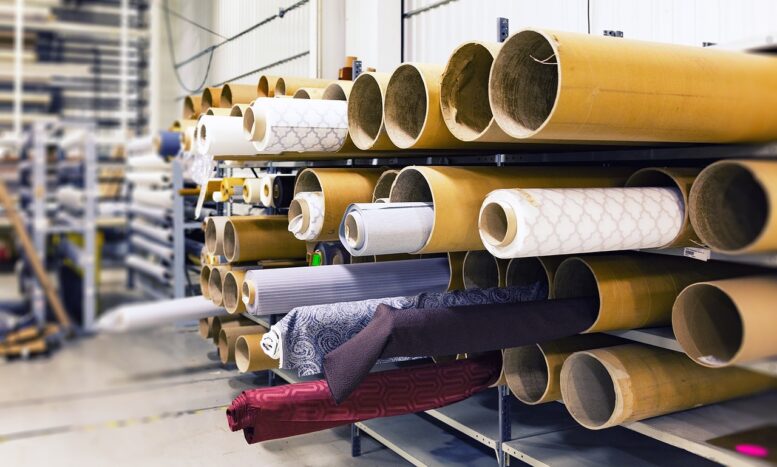Textile Industry is one of the major manufacturing industries of our country. It meets the demand of humans with regard to attire and this attire is brought to the trade after a particular plan of action.
Textile Industry in India entails the transformation of fibre into yarn, and yarn to the fabric. These are later printed or dyed, stitched into clothes, which are then turned into household items, clothing, and different industrial products. Yarn is made from different kinds of fibres.
The textile manufacturing process is not an outcome of a few steps but it does undergo several stages.
The Phases of Manufacturing Are
- Spinning
- Weaving
- Dyeing, Printing, Finishing
- Garments Manufacturing and transportation
The description of the following stages are explained below-
1. Spinning Process
Under the procedure of spinning the fibre material is converted into yarn. This transformation goes through various levels
- Step 1: Blow room process
- Step 2: Carding
- Step 3: Combining
- Step 4: Drawing
- Step 5: Roving
- Step 6: Cone winding
On its initial stage, it passes through the blow room, where the size of cotton is highly reduced with the aid of machines followed by the process of carding. As the yarn is arranged in a parallel method, it is straightened again in the stage of combining. After combining, the procedure is resumed by drawing which includes reducing in spinning mills. The silver material fabricated by drawing is processed for blending where a compatible size of the cloth is obtained. This is then stepped ahead for a roving process for the objective to produce input collection. This roving process is reduced by big rollers and then circle around the rotating axis. Or simply we can say spinning machines takes the roving, twist and thins it, creating yarn. It is very crucial to employ the winding devices properly to steer clear of the loss of spinning mills as well as customers.
Related Post: How to Tie a Tie: A Comprehensive Guide.
2. Weaving Process
The second level is weaving. It is a process of interlacing two kinds of yarn called a warp or ends. Yarn is passed in the following steps:
- STEP 1: Yarn from the spinning process
- STEP 2: Doubling and twisting
- STEP 3: Winding
- STEP 4: Creeling
- STEP 5: Warping
- STEP 6: Sizing
- STEP 7: Winding on weavers beam
- STEP 8: Weaving
The yarn is sent for twisting and doubling after the spinning process. It is then prepared for moving the yarn in the appropriate set up of package, accommodating adequate yarn length. The process of moving yarn from a ring into a convenient package is named winding.
After this, the process of creeling takes place, where the full packages which are ready to be unwound are placed. Plainly, it is the removal of worn-out packages as well as their replacement with new ones, which are then wrapped properly.
Afterwards, the yarn is provided with the coating to reduce the chances of the wreckage of yarn which is called the sizing process. It is observed as a significant part of the procedure. It is then prepared on the weaver’s beam for winding, assisted by the ending stage of weaving. There are largely three specific types of weaves which are – Plain weave, Twill weave and Satin weave.
Related Post: New Fashion Trend – Comfortable, Indigenous, and Love-getter.
3. Dyeing, Printing, Finishing
The process of dyeing and printing of textile materials are generally carried out before the utilization of other end products to the material in dyeing mills.
Dyeing is executed with an anionic direct dye by entirely submerging the yarn or fabric in an aqueous dye according to the prescribed procedure. Whereas printing is the process of applying colour paste or colour ink to the fabric’s surface, in a pattern that is predetermined. It may be observed as localised dyeing.
It improves the appearance of the product by adding colour to it. The product is then transformed into knitted cloth from woven cloth. This is known as the finishing process. Finishing is particularly carried out following printing or dyeing to provide a peculiar look.
4. Garments Manufacturing and transport
Garment manufacturing is the last procedure that converts semi-prepared cloth into finalized cloth. There are several different stages that need to be completed by clothes manufacturing companies for the fabrication of cloth.
These processes covers – Costing, Designing, Sewing, Sampling, the addition of buttons and zippersMaker Making, Cutting, Washing, Final Inspection, Finishing, Packing, Dispatch and much more.
After the completion of manufacturing, the responsibility of transporting the product safely to the desired market is the big one. One should look for all the options available before finalising the particular mode of transportation.
The above steps will provide you with a brief idea about the textile manufacturing process in India. From the information provided you might receive a legit notion that manufacturing a cloth consists of lengthy and heavy mechanical procedures and is definitely not an outcome of simply generated steps.
The traditional textile manufacturing process is replaced by electronic textile machinery. This made the process of converting raw materials into finished goods real easy.
Also Read: Textile Industry hit hard by Covid, but aiming high despite challenges

1 Comment